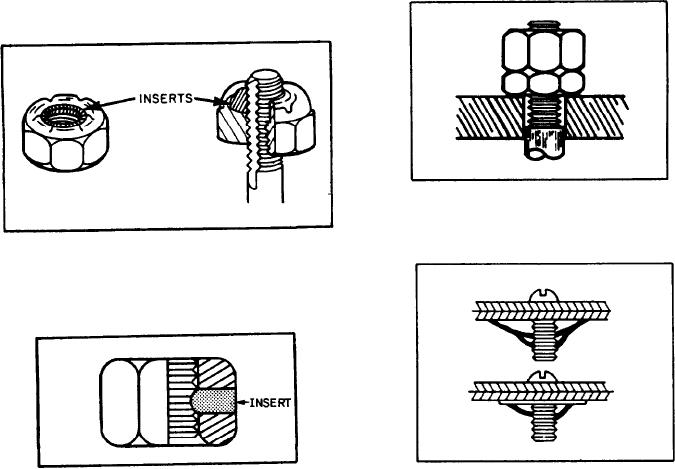
They force the nut to the side, cocking it slightly.
LOCKNUTS
This produces frictional forces on one side of the
Locknuts are used in special applications
bolt thread. Although the plastic insert locks
where you want to ensure that the components
without seating, proper torque applied to the nut
joined by the fasteners will not loosen. Two types
stretches the bolt, creating clamping forces that
of locknuts are in common use. The first type
add to the locking abilities of the nut. Before
applies pressure to the bolt thread and can be
reusing nylon insert nuts (fig. 6-53), check the
used where frequent removal may be required.
inserts. If worn or torn, discard the nut. Install
The second type deforms the bolt thread and is
the nut (on clean lightly lubricated threads) finger
used only where frequent removal is unnecessary.
tight. If you can install the nut to the point where
The first type includes plastic ring nuts, nylon
the bolt threads pass the insert without a wrench,
insert nuts, jam nuts, spring nuts, and spring
discard the nut and use a new one.
beam nuts. The second type includes distorted
collar nuts and distorted thread nuts; they are not
Jam Nuts
commonly found in gas turbine equipment and
You should install jam nuts (fig. 6-54) with
will not be covered in this section.
the thinner nut to the working surface and the
Plastic Ring Nuts
thicker nut to the outside. The thin nut is
deformed by the wider nut and pressed against
Plastic ring nuts (fig. 6-52) deform the plastic
the working surface and threads.
insert when they are installed. The resilient plastic
material is forced to assume the shape of the
Spring Nuts
mating threads, creating large frictional forces.
Spring nuts (fig. 6-55) lock by the side grip
Nylon Insert Nuts
on the bolt. When tightened, the spring nut
Nylon insert nuts have plastic inserts (plugs)
that do not extend completely around the threads.
Figure 6-54.--Jam nuts.
Figure 6-52.--Plastic ring nut.
Figure 6-55.--Spring nuts.
Figure 6-53.--Nylon insert nut.
6-38

